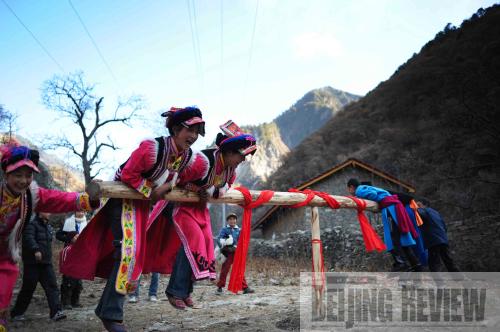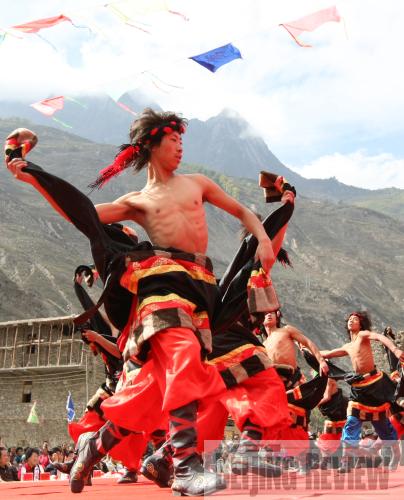|
 |
|
FOLK CUSTOM: Young people of the Qiang ethnic group play a traditional game (LIU JIE) |
Four counties in southwest China's Sichuan Province recently applied to have a traditional festival included in the list of world intangible cultural heritage of the United Nations Educational, Scientific and Cultural Organization (UNESCO). The move will also go a long way to preserve what is left of an ancient culture teetering on the brink of extinction.
In January, the Qiang ethnic minority in Beichuan, Maoxian, Lixian and Wenchuan counties submitted its application to promote the longevity of the Qiang Nian Festival, the New Year celebrated by the Qiang people.
The festival falls on the first day of the 10th month in the lunar calendar of China. According to the folk customs of this nationality, people would hold various activities, such as offering sacrifices to the God of Heaven, God of Mountain and God of Village.
The festival normally lasts three to five days, but some villages spend 10 days on celebration, eating, drinking and dancing. Most ceremonies are presided over by a shaman.
The most senior villager is in charge of opening the crocks of locally brewed wine. Songs sung are mainly romantic duets and dances are done collectively to celebrate the festival, accompanied by various local instruments, such as Qiang flutes, drums and gongs. Normally tens of people participate in the dance, creating a convivial atmosphere. Besides dancing, young people will also hold various sports activities, such as the pushing wood pole competition. The winner receives wine presented by girls watching the games.
Harvest bounty
As the Qiang Nian Festival occurs in the season when livestock grow fat and strong and the grains, vegetables and fruits ripen, the festival is seen as a harvest time to enjoy feasts after a year of hard work. During the festival, family members, relatives and friends visit each other's homes.
 |
|
BE TOUGH: Qiang people celebrate the first Qiang Nian Festival after the May 12 earthquake ZHU JIFANGUO | Besides providing gifts to deities, the Qiang people would also make sacrifices to their ancestors. The offerings in the ancestor worship ceremonies are normally made of flour in shapes of chicken, sheep or oxen. After the memorial rites, people send mutton used as part of the sacrifice to other families in the same village.
There is a special rule in some areas that people in a village will celebrate the Qiang Nian Festival only when none of the adults in their village have died in the past year, or if so, they will only celebrate the Spring Festival, the Chinese New Year.
Disappearing culture
As one of the ancient ethnic groups of China with a 3,000-year history, the Qiang nationality is an ethnic group in Asia known for its culture of herding and agriculture. In the inscriptions found on tortoise shells and animal bones, the earliest Chinese characters found today, archaeologists discovered that the only sign related to minorities was a symbol meaning Qiang, which shows that their history dates back to the Shang Dynasty (1600-1046 B.C.) at least.
| 